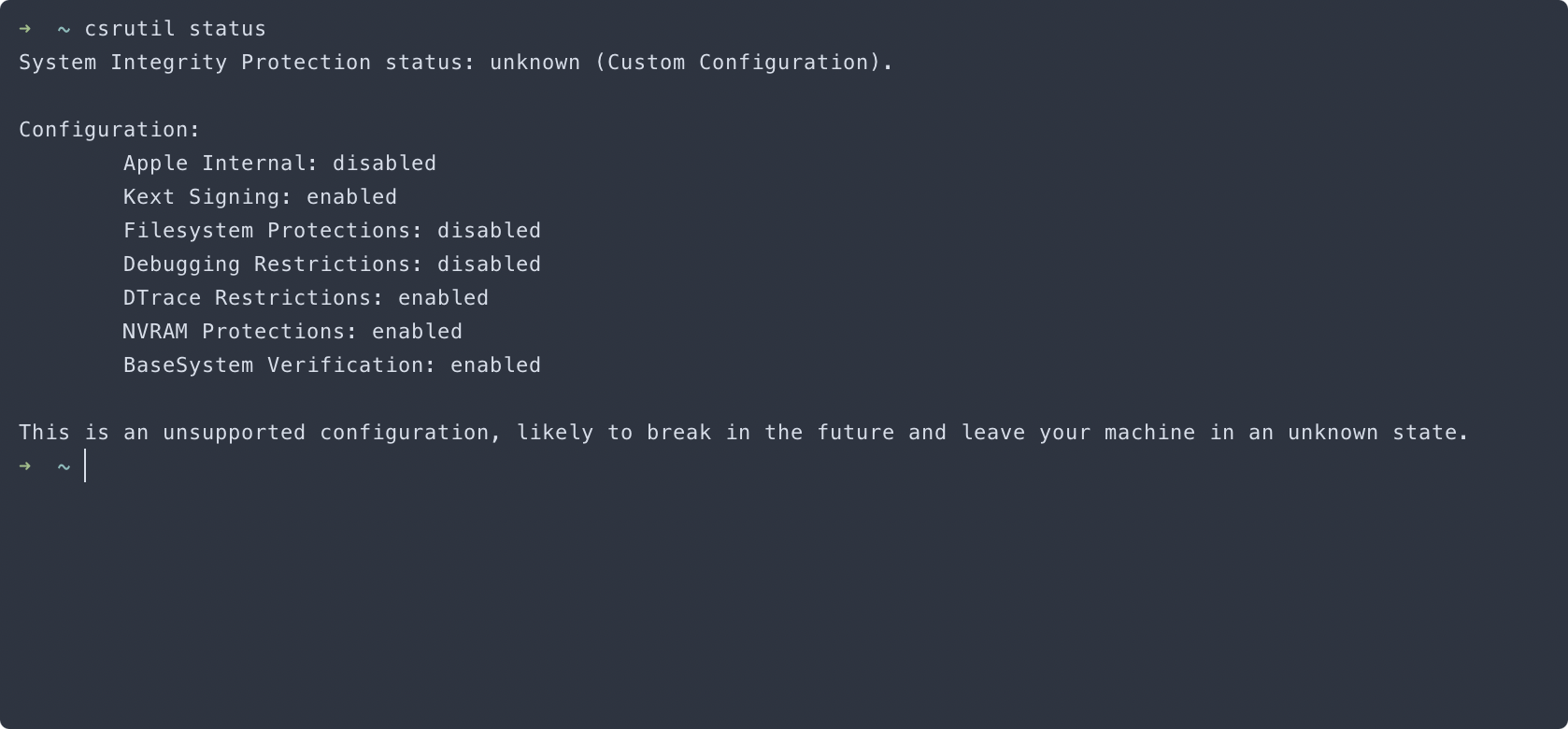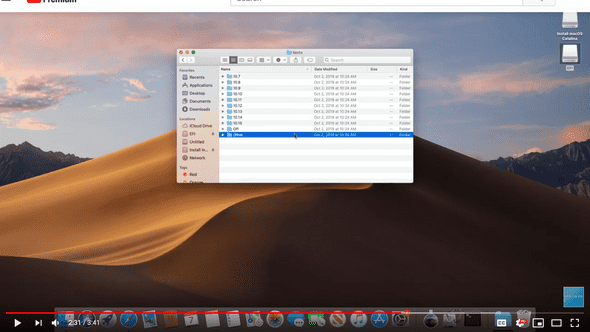
- #OSX EDNABLE CSRUTIL AFTER OPENZFS INSTALL HOW TO#
- #OSX EDNABLE CSRUTIL AFTER OPENZFS INSTALL INSTALL#
- #OSX EDNABLE CSRUTIL AFTER OPENZFS INSTALL FULL#
- #OSX EDNABLE CSRUTIL AFTER OPENZFS INSTALL SOFTWARE#
- #OSX EDNABLE CSRUTIL AFTER OPENZFS INSTALL CODE#
#OSX EDNABLE CSRUTIL AFTER OPENZFS INSTALL INSTALL#
To make this change persist across Proxmox reboots, run: echo "options kvm ignore_msrs=Y" > /etc/modprobe.d/kvm.conf & update-initramfs -k all -u Install Big Sur On Proxmox, run “echo 1 > /sys/module/kvm/parameters/ignore_msrs” to avoid a bootloop during macOS boot.
#OSX EDNABLE CSRUTIL AFTER OPENZFS INSTALL HOW TO#
See Also » CENTOS7 – vnc server remote desktop setup howto screen sharing in 2018 – x11vnc error: socket: Address family not supported by protocol (97) Modular Synchronization Platform LANTIME M1000 How to Setup Ubuntu Server as a Router using PPPoE args: -device isa-applesmc,osk="." -smbios type=2 -device usb-kbd,bus=ehci.0,port=2 -cpu host,kvm=on,vendor=GenuineIntel,+kvm_pv_unhalt,+kvm_pv_eoi,+hypervisor,+invtscballoon: 0bios: ovmfbootdisk: ide2cores: 4cpu: Penrynefidisk0: vms:vm-100-disk-1,size=1Mide0: isos:iso/BigSur-full.img,cache=unsafe,size=2094688Kide2: isos:iso/OpenCore-v10.img,cache=unsafe,size=150M machine: q35memory: 4096name: bigsurnet0: vmxnet3=.,bridge=vmbr0,firewall=1numa: 1ostype: othervirtio0: vms:vm-100-disk-0,cache=unsafe,discard=on,size=64Gscsihw: virtio-scsi-pcismbios1: uuid=.sockets: 1vga: vmware Configure Proxmox Your final VM configuration file should resemble this: Save your changes, return to the Options tab, and change the boot order to put IDE2 (the OpenCore image) first. This will treat these as hard disks rather than DVD drives. Now find the lines that define the two “ISOs” (ide0 and ide2), and remove the “,media=cdrom” part from them. Features that your host CPU doesn’t support will be ignored (a warning will be printed to the console during launch with qm start 1xx), but note that macOS won’t work without SSE4.2 support. This pretends that your CPU is Penryn, which will keep macOS happy even if your host CPU is AMD, and adds a bunch of newer required and optional CPU features on top. If your host CPU is AMD, or the above argument doesn’t work for you, use this more-compatible alternative: -cpu Penryn,kvm=on,vendor=GenuineIntel,+kvm_pv_unhalt,+kvm_pv_eoi,+hypervisor,+invtsc,+pcid,+ssse3,+sse4.2,+popcnt,+avx,+avx2,+aes,+fma,+fma4,+bmi1,+bmi2,+xsave,+xsaveopt,check OpenCore’s config will pretend to macOS that the CPU’s model name is Penryn for compatibility. This will pass through all of the features that your CPU supports. cpu host,kvm=on,vendor=GenuineIntel,+kvm_pv_unhalt,+kvm_pv_eoi,+hypervisor,+invtsc In a command prompt, change into the same directory as that file and run:
#OSX EDNABLE CSRUTIL AFTER OPENZFS INSTALL CODE#
Save the first block of C code from this page as smc_read.c. You can get around this by reading anauthentication key out of your real Mac hardware (the OSK key).

MacOS checks that it is running on real Mac hardware, and refuses to boot on third-party hardware. (You need v12 or newer for Big Sur 11.3 or newer) Fetch the OSK authentication key iso file extension, this is actually a hard disk image. Prepare an OpenCore imageĭownload the file from the newest release in my repository (that says it’s Big Sur compatible), double click it to unpack it, and upload it to Proxmox’s ISO store at /var/lib/vz/template/iso. This option is not available when building the installer on Linux. Simply ask it to build BigSur-full.img instead: cd scripts/bigsurmake BigSur-full.img
#OSX EDNABLE CSRUTIL AFTER OPENZFS INSTALL FULL#
If you’re building the installer on macOS, you can build a full installer instead of just a recovery, which will mean that macOS won’t have to download Big Sur files during installation, and so won’t require an Internet connection. Although we’re putting it in the ISO directory so that we can use it with Proxmox’s ISO picker later, this a raw disk image rather than a true ISO. Upload this file to your Proxmox’s ISO store directory (typically /var/lib/vz/template/iso).
#OSX EDNABLE CSRUTIL AFTER OPENZFS INSTALL SOFTWARE#
This will download the Big Sur installer from Apple’s software distribution servers and build a BigSur-recovery.img file for you. Now in the Terminal, from the root of OSX-KVM, run: cd scripts/bigsurmake BigSur-recovery.img If you’re building the ISO on Linux, you instead need to run this command (these are the package names for Ubuntu or similar distributions, they may need adjustment on other distributions): sudo apt install qemu-utils make If you will be building the installer ISO on macOS, open up the Terminal and run this command to install the commandline tools: xcode-select -install

Download my copy of the OSX-KVM repository using the download button, and unzip it:įirst we need to install some build requirements.


 0 kommentar(er)
0 kommentar(er)
